All-in wrestling was the first wave of professional wrestling in the United Kingdom to be based on the catch as catch can style of wrestling. It was conducted under the All-In rules of 1930 in which (unlike Olympic freestyle wrestling) no holds were prohibited. [1] [2]
The name All In later became synonymous with more anarchic professional wrestling shows, leading to censure by local authorities by the late 1930s. Consequently, the All In label was disowned by most British wrestling promoters following the adoption of the 1947 Mountevans rules. [2]
Professional wrestling in the Greco Roman style had enjoyed considerable popularity in Britain during the Edwardian era, but had dwindled and died out by the outbreak of World War I. While various styles of amateur wrestling continued as legitimate sports, grappling as a promotional business did not return to Britain until the beginning of the 1930s when the success of the more worked aspects of professional wrestling in America, like gimmickry and showmanship, were introduced to British wrestling.
It was with this revival that the more submission-based Catch As Catch Can wrestling style, which had already replaced Greco Roman wrestling as the dominant style of professional wrestling in the United States back in the 1890s, became the new dominant style in Britain. With Lancashire catch-as-catch-can already a major amateur sport particularly in Northern England, there existed a ready-made source of potential recruits to professional wrestling.
Amateur wrestler Sir Atholl Oakeley got together with fellow grappler Henry Irslinger to launch one of the first promotions to employ the new style of wrestling which was coined "All-in" wrestling. Though, like many wrestlers throughout the business, Oakley would claim his wrestling was entirely legitimate, his claim was highly dubious. According to Pro Wrestling Press , Under the British Wrestling Association banner, Oakley's promotion took off with wrestlers such as Tommy Mann, Black Butcher Johnson, Jack Pye, Norman the Butcher, College Boy, and Jack Sherry on the roster, while Oakley himself would win a series of matches to be crowned the first British Heavyweight Champion. [3]
The business was reaching one of its highest points at the time, with the best part of forty regular venues in London alone. The 1930s craze for 'All in' wrestling went by the wayside when quality was sacrificed for quantity. The great demand for wrestling, however, meant there were not enough skilled amateurs to go around, and many promoters switched to more violent styles, with weapons and chairshots part of the proceedings. Women wrestlers and mud-filled rings also became common place. In the late 1930s, the London County Council banned professional wrestling, leaving the business in rough shape just before World War II. [4] Permits were also revoked in Johannesburg, South Africa in 1938. [5] In April 1938, Justice Charles of the King's Bench Division in London declared that it was "not a sport." [6]
After the war, attempts to relaunch the business in 1947 failed to catch on with journalists who condemned the gimmickry calling the show fake. The revelation of this, and the general chaos which had surrounded All In Wrestling prior to the War, prompted Admiral Lord Mountevans, a fan of the sport, to get together with Commander Campbell (a member of the popular "The Brains Trust" radio panel show), member of parliament Maurice Webb and Olympic wrestler Norman Morell to create a committee to produce official rules for wrestling. Subsequently, the term All In was largely disowned by British promoters, who now referred to their style of wrestling as Modern Freestyle. [2]
Despite the rejection of the name "All In" by British wrestling promoters, the term continued to be used in the UK to refer to professional wrestling - often in a derogatory sense by non-fans. An example of its use in this context is in the Monty Python's Flying Circus sketch "All In Cricket" which depicts two cricketers dueling with cricket bats in a wrestling ring. [7]
English translations of Mythologies by Roland Barthes have frequently rendered the French term Le Catch as All In wrestling, (despite Barthes having written the book in France in the 1950s). [8]

Professional wrestling is an athletic form of theater that revolves around mock combat performed in a squared ring. The storylines are typically based around interpersonal conflicts between good-natured "faces" and villainous "heels". While the ring is the main stage, additional scenes may be recorded for television in the backstage areas of the venue, in a format similar to reality television.
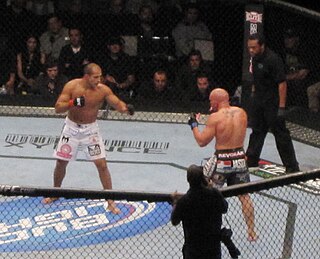
Mixed martial arts (MMA) is a full-contact combat sport based on striking, grappling and ground fighting, incorporating techniques from various combat sports from around the world. The first documented use of the term mixed martial arts was in a review of UFC 1 by television critic Howard Rosenberg in 1993.

Aloysius Martin Thesz, known by the ring name Lou Thesz, was an American professional wrestler. Considered to be one of the last true shooters in professional wrestling and described as the "quintessential athlete" and a "polished warrior who could break a man in two if pushed the wrong way", Thesz is widely regarded as one of the greatest wrestlers of all time and the single greatest wrestling world champion in history, and probably the last globally accepted world champion.

Professional wrestling in the United Kingdom spans over one hundred years but became popular when the then new independent television network ITV began showing it in 1955, firstly on Saturday afternoons and then also in a late-night midweek slot. It was at its peak of popularity when the television show World of Sport was launched in the mid-1960s, making household names out of Adrian Street, Mick McManus, Count Bartelli, Giant Haystacks, Jackie Pallo, Big Daddy, Steve Veidor, Dynamite Kid, and Kendo Nagasaki.
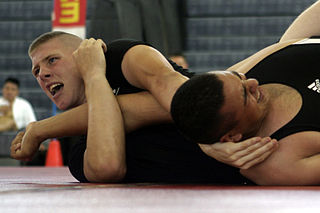
Submission wrestling, also known as submission grappling, submission fighting or simply grappling, is a competitive martial art and combat sport that focuses on ground fighting and submission techniques. It is a hybrid discipline that incorporates elements of various grappling arts, mostly Brazilian jiu-jitsu but also Judo, Sambo, and wrestling. Submission wrestling is practiced both as a competitive sport and as a training method for self-defence and mixed martial arts (MMA).

Wrestling is a martial art and combat sport that involves grappling with an opponent and striving to obtain a position of advantage through different throws or techniques, within a given ruleset. Wrestling involves different grappling-type techniques such as clinch fighting, throws and takedowns, joint locks, pins, and other grappling holds. Many different wrestling techniques have been incorporated into martial arts, combat sports, and military systems. Wrestling can either be genuine competition or athletic theater.
Welterweight is a weight class in combat sports. Originally the term "welterweight" was used only in boxing, but other combat sports like Muay Thai, taekwondo, and mixed martial arts also use it for their own weight division system to classify the opponents. In most sports that use it, welterweight is heavier than lightweight but lighter than middleweight.
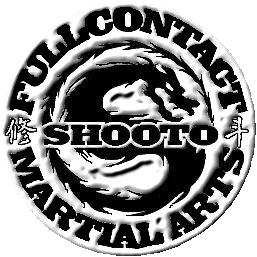
Shooto is a combat sport and mixed martial arts organization that is governed by the Shooto Association and the International Shooto Commission. Shooto was originally formed in 1985, first as a particular fighting system and then in 1989 as a mixed martial arts promotion. It is considered one of the first true mixed martial arts competitions, with its Vale Tudo Japan events being essential to the rise of PRIDE Fighting Championships and the development of modern MMA. Many Japanese MMA fighters had their start at Shooto and the organization still holds both professional and amateur tournaments.
Shoot wrestling is a combat sport that originated in Japan's professional wrestling circuit (Puroresu) of the 1970s. Professional wrestlers of that era attempted to use more realistic or even "full contact" moves in their matches to increase their excitement, diminishing or eschewing the theatrical elements, looking more similar to an actual, unscripted fight. The name "shoot wrestling" comes from the professional wrestling term "shoot", which refers to any unscripted occurrence within a scripted wrestling event. Shoot wrestling incorporated realistic moves from submission grappling and various kickboxing styles. It was particularly inspired and influenced by catch wrestling, a form of wrestling with submissions that was the predominant style of professional wrestling in the 19th and early 20th century, at the time not yet predetermined.

Catch wrestling is a classical hybrid grappling style and combat sport. It was popularised by wrestlers of travelling funfairs who developed their own submission holds, or "hooks", into their wrestling to increase their effectiveness against their opponents. Catch wrestling derives from various different international styles of wrestling: several English styles. The training of some modern submission wrestlers, professional wrestlers and mixed martial artists is founded in catch wrestling.
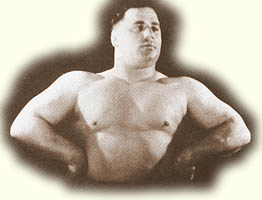
Bartolomeo "Bert" Assirati, was an English professional wrestler who became a multiple-time British Heavyweight Champion, and, posthumously, a charter member of the Wrestling Observer Newsletter Hall of Fame. He was known for displaying various feats of strength, including setting a British record in 1938 by lying on his back, and pulling over at arm's length a 200-pound barbell. At 240 pounds, Assirati was one of the heaviest men to perform the iron cross.
John Lowing is a retired British professional wrestler best known under the ring name Johnny Kidd. Kidd was best known for his work during what was known as the Golden Era of British Wrestling.

Rhoscolyn is a village and community located on Holy Island, Anglesey, Wales. It is just over five miles south of Holyhead and is the most southerly settlement on the island. The name Rhoscolyn is said to mean "The Moor" (Rhos) of The Column (colyn), referring to a pillar which the Romans put up to mark the edge of their territories. The community population taken from the 2011 census was 542.
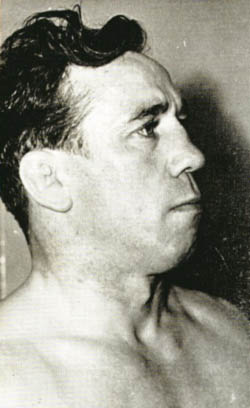
Thomas Moore was a British professional wrestler, best known by his ring name Jack Dempsey, who was active in North American and European regional promotions from the 1930s to the 1960s.

The history of professional wrestling, as a performing art, started in the early 20th century, with predecessors in funfair and variety strongman and wrestling performances in the 19th century.

Wrestling and grappling sports have a long and complicated history, stretching into prehistoric times. Many traditional forms survive, grouped under the term folk wrestling. More formal systems have been codified in various forms of martial arts worldwide, where grappling techniques form a significant subset of unarmed fighting.
Sir Edward Atholl Oakeley, 7th Baronet, of Shrewsbury, known under the ring name Atholl Oakeley, was a British professional wrestler and wrestling promoter who was one of the pioneers of professional wrestling in the United Kingdom. He was Britain's first heavyweight all-in wrestling champion, and held the title from 1930 to 1935. He became the European heavyweight champion in 1932.
In professional wrestling, a weight class is a standardized weight range for the wrestlers. The top class in almost every promotion is heavyweight, but super heavyweights exist. Weight class matches in modern-day American professional wrestling are rare, but weight class championships still exist. However, Japanese professional wrestling, Mexican wrestling and traditional British wrestling use the weight classes more seriously.
Admiral-Lord Mountevans rules are a set of professional wrestling rules mainly used in British wrestling. They were named after Edward Evans, 1st Baron Mountevans, who ordered a unified set of rules written up for professional wrestling in the British Isles. The style of wrestling under the Mountevans rules was advertised by promoters as Modern Freestyle Wrestling.
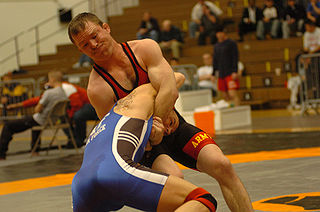
The different styles of wrestling may be classified in various ways, such as: